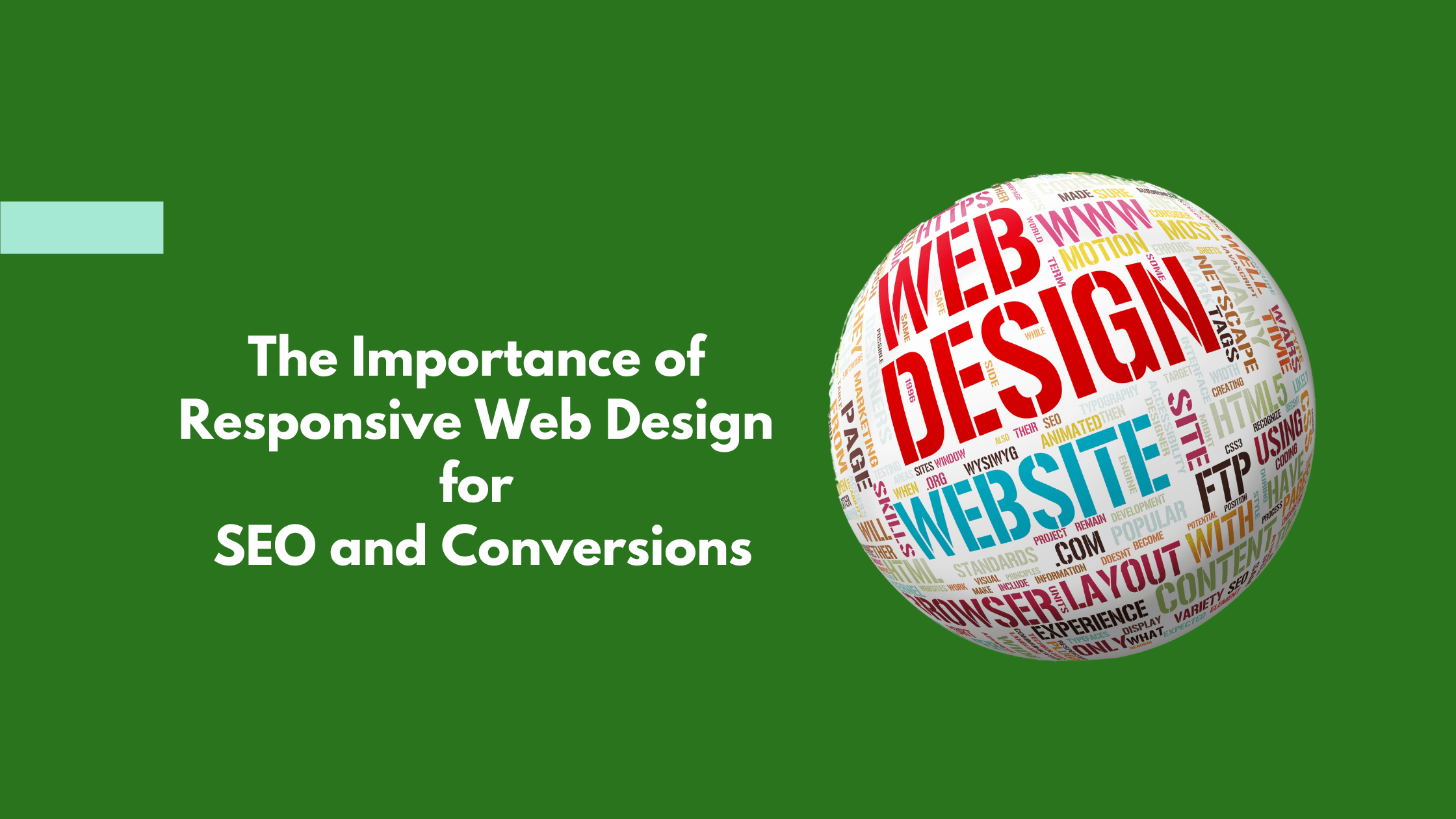If we’re being honest, your website is the foundation of your online presence. But have you ever taken time to think about how having a responsive web design can help your business maximize opportunities? A well-designed website plays a direct role in your business growth and that’s why you need to understand how website design services for business growth can set you apart.
Recent research indicates that over 58% of global website traffic comes from mobile devices, which means more than half of your visitors are checking out your site from their phones or tablets.
Now, imagine not optimizing your website for mobile users; just like that, you’re losing a greater percentage of your traffic. When visitors land on a slow, unresponsive page that forces them to zoom in, pinch the screen, or struggle with clunky navigation, they’ll leave you for your competitors. Think about it—would you stick around on a website that makes you pinch and zoom just to read the text? Probably not. And neither will your customers.
On the flip side, a mobile-friendly website automatically adjusts to different screen sizes, provides a seamless experience whether visitors are browsing on a desktop, tablet, or smartphone, helps you rank higher on Google, and boosts your conversion rates.
However, if your website isn’t mobile-optimized, you’re missing out on a lot of business opportunities. That’s why in this guide, we’ll break down why responsive web design is non-negotiable for SEO and conversions, how it impacts user behaviour, and what you can do to ensure your site performs at its best across all devices.
In that case, let’s start by understanding what responsive web design is.
Table of Contents
What Is Responsive Web Design?
Responsive web design is an approach that ensures your website automatically adjusts its layout, images, and elements to fit any screen size.
In recent times, people use all kinds of devices like smartphones, tablets, laptops, desktops, and even smart TVs to browse the internet and if your website doesn’t adjust seamlessly to different screen sizes, you’re creating a frustrating experience for visitors.
So instead of building separate versions of your site for desktop and mobile, a responsive site adapts dynamically based on the user’s device.
This means no more awkward zooming, endless scrolling, or broken layouts, just a smooth, user-friendly experience every time.
How Responsive Web Design Works
A well-designed mobile-friendly website doesn’t just shrink everything to fit a smaller screen, no. Instead, it uses fluid grids and flexible layouts to ensure that elements resize proportionally without being set to fixed widths. Images and text adjust automatically, maintaining readability and proper formatting on any device.
Whether someone visits your site on a smartphone, tablet, or laptop, they get a consistent experience without frustrating usability issues. This kind of seamless adaptability keeps users engaged and improves your conversions by up to 30%.
Responsive vs. Adaptive vs. Mobile-Friendly Website Design
Understanding the differences between all design approaches is quite important because not all mobile-friendly designs are created equal.
Responsive design is the most flexible option because it adjusts dynamically to any screen size, providing a smooth experience across all devices. Adaptive design, on the other hand, relies on predefined layouts for specific devices, meaning it can look great on some screens but may not scale well across others. Meanwhile, a basic mobile-friendly design simply ensures that a site functions on mobile devices but doesn’t necessarily adjust dynamically, often leading to clunky navigation or formatting issues.
And if you’re wondering which one is the best choice, we’ll tell you it’s responsive design. Why? Because of your SEO and user experience. Remember Google prioritizes mobile-first indexing, which means that how well your site performs on mobile directly affects its visibility, bounce rates and conversions.
Do you desire a responsive and SEO-optimized website that looks great and functions perfectly on any device? Then, get in touch with us at Texttot Digital for a free consultation, let’s talk about how to make your website work for your business.
Why Responsiveness Matters for SEO
One thing Google has made clear is that mobile-friendliness is non-negotiable when it comes to ranking in search results.
Google primarily evaluates your site’s mobile version rather than its desktop counterpart. That means if your website isn’t optimized for mobile users, you’re hurting your user experience and you’re also damaging your search engine rankings.
Without a doubt, a poorly designed mobile experience will lead to high bounce rates, slow load times, and frustrated visitors who leave without engaging. Google, however, sees this behaviour as a red flag and pushes unresponsive sites further down in rankings.
On the flip side, a responsive web design will ensure that your site adapts seamlessly to different devices, keeping visitors engaged and boosting your chances of ranking higher on search engine results pages.
How Does Responsive Design Boost SEO?
Google’s mobile-first indexing means that mobile-friendly sites have a direct advantage in search rankings, and a responsive web design ensures that all your content is accessible, readable, and navigable on any device, giving Google exactly what it prefers. So, if your site isn’t optimized for mobile, you’re automatically at a disadvantage, no matter how good your desktop experience is.
A well-designed mobile-friendly website also reduces bounce rates. When users land on your site and get a seamless experience, they tend to stay longer, explore more pages, and interact with your content, which, in turn, helps to improve SEO. But if they find your site difficult to navigate, or interact with, they’ll leave instantly. A bounce rate above 60% is usually a bad sign for SEO and Google interprets this as a sign that your content isn’t relevant or engaging, which can lower your rankings.
Page speed is another important factor. Research shows that 53% of mobile users abandon sites that take longer than 3 seconds to load. One of the few things every business owner needs to know about website speed is that Google considers load time as a ranking factor; and slow-loading sites, especially on mobile, get penalized. Having a responsive web design will ensure optimized images, efficient coding, and fast-loading elements, making sure that visitors aren’t stuck waiting for content to appear.
Google’s Core Web Vitals also play a role in SEO, focusing on metrics like Largest Contentful Paint (LCP), First Input Delay (FID), and Cumulative Layout Shift (CLS). These metrics measure how quickly your site loads, responds to user interactions and maintains a stable layout respectfully.
A well-optimized SEO web design will have these metrics to ensure a smooth, frustration-free user experience, which of course, Google rewards with better rankings. However, if you haven’t already optimized your website for SEO, use our ultimate SEO checklist for business websites to ensure you’re covering all bases.
Lastly, a mobile-friendly website enhances structured data and mobile usability. Search engines rely on structured data to understand and rank content effectively. But if your website isn’t optimized for mobile, search engines may struggle to interpret your pages correctly, and that may reduce your chances of appearing in rich search results, featured snippets, and local listings.
The Impact of Mobile-Friendly Design on Conversions
Ranking high on search engines is only half the battle. Your website may be getting plenty of traffic but a poor mobile experience will kill conversions. When users struggle with slow load times, difficult navigation, or clunky checkout forms, they won’t stick around, they’ll leave and take their money elsewhere.
Think about it. How many times have you clicked on a website from your phone, only to bounce within seconds because the text was too small the buttons were hard to tap, or the page took forever to load? You see, your visitors feel the same frustration. If your website doesn’t offer a smooth mobile experience, you’re definitely losing potential customers every single day.
How Will Mobile Optimization Increase Conversions?
A seamless mobile experience removes friction from your customer’s journey, making it easier for them to take action, whether that’s signing up, making a purchase, or booking a service. When navigation is effortless and pages load instantly, at least, 79% of users are more likely to revisit and even share a mobile site.
Mobile-friendly CTAs drive higher click-through rates. If your buttons and forms aren’t designed for touchscreens, users will struggle to take action. A well-optimized mobile-friendly website places CTAs in easy-to-reach areas, sizes buttons appropriately, and ensures forms are quick and simple to fill out. When users can take action effortlessly, conversion rates increase. A study found that optimizing CTAs for mobile devices can improve conversion rates by 32.5%.
Mobile vs. Desktop Traffic
Optimizing your website for mobile users is indeed a big deal. More people are browsing the internet on mobile than ever before. Not less than 67% of users prefer a responsive website when shopping on smartphones, and not optimizing your website translates to ignoring more than half of your potential audience.
Mobile users are also more likely to make impulse purchases, but only if the experience is seamless. For example, 62% of businesses report increased sales as a result of responsive websites.
The connection is clear; to turn your website into a powerful sales machine, you need a fast, mobile-friendly, SEO-optimized site that will also function as your lead-generation website.
Key Elements of a Mobile-Friendly Website
A high-performing, mobile-friendly website isn’t just about looking good on a smaller screen. It’s very much about providing a seamless, intuitive experience that keeps visitors engaged and drives conversions.
A mobile-friendly website has a 40% higher conversion rate than a non-optimized one. So, whether you’re running an online store, a service-based business, or a content-driven site, optimizing for mobile is non-negotiable.
To ensure your responsive web design delivers the best results, what are the essential elements to focus on?
Fast Loading Speed
Speed is everything in today’s digital landscape. A slow-loading website does nothing but frustrate visitors and drive them away before they even see your content. And since Google considers page speed a ranking factor, a sluggish site can hurt your SEO and lower your visibility in search results.
To optimize for speed, you start by compressing images, enabling browser caching, and minifying CSS, JavaScript, and HTML. By research, a well-optimized, mobile-friendly website is supposed to load in under three seconds, to keep users engaged and reduce bounce rates.
Easy Navigation and Intuitive Layout
Having a cluttered, confusing website will frustrate your users and send them elsewhere, so make sure your navigation is simple, intuitive, and accessible with just a few taps.
And for mobile users, that translates to clear, expandable menus, well-placed buttons, and a thumb-friendly layout that makes it easy to browse. According to a study, one bad user experience would cause you to lose 30% of your customers. That’s why you make sure your users never have to struggle to find what they need, whether it’s a product, a service page, or a contact form.
Readable Fonts and Proper Touch Elements
If users have to pinch, zoom, or squint to read your content, your site isn’t optimized for mobile. A responsive web design will ensure that text is legible on all screen sizes without extra effort from the user.
Buttons and links should be large enough to tap easily without misclicking. Google recommends at least 48px by 48px for touch targets, ensuring a frustration-free experience.
Mobile-Friendly CTAs and Checkout Processes
Calls-to-action (CTAs) are what drive conversions, but if they’re poorly placed or hard to tap, users won’t engage with them.
A mobile-friendly website places clear, actionable CTAs in highly visible areas, making it easy for users to sign up, purchase, or contact your business.
For e-commerce sites, a smooth checkout process is very important. Businesses that optimize their checkout see an average of 35% increase in mobile conversion rates. The trick? The easier it is to complete a transaction, the higher your conversion rates. So, think of one-click checkouts like Apple Pay, Google Pay or any other feasible option.
Responsive Images and Media
A responsive web design automatically resizes images and media to fit different screen sizes without compromising quality.
And large, unoptimized images slow down your site and disrupt the user experience, so use modern formats like WebP, implement lazy loading to delay non-essential images, and ensure videos scale properly without requiring unnecessary scrolling or zooming.
SEO Structure and Mobile Usability
A mobile-friendly website isn’t only about the design, but content and properly structuring it for search engines. That’s why web design and content go hand-in-hand to ensure the effective integration of design and content. Also, using clean code, proper heading tags (H1, H2, etc.), and structured data helps Google understand and rank your content.
Additionally, avoid intrusive and aggressive pop-ups that block content and frustrate mobile users. Google penalizes websites like this, so keep promotions subtle and user-friendly.
How to Optimize Your Website for Mobile and SEO
When you think of a mobile-friendly website, think of performance, speed, and user experience. However, remember that one of the biggest factors influencing user experience is branding and understanding the role of branding in web design improves your website’s mobile-friendliness.
With Google’s mobile-first indexing, your rankings now depend on how well your site functions on mobile devices. If it’s slow, difficult to navigate, or unresponsive, you’re losing potential customers and crippling your SEO at the same time, but the good news? A well-structured responsive web design can solve these issues and ensure your site adapts seamlessly across devices while maintaining high performance.
What are the steps to follow?
Use a Responsive Web Design Framework
A responsive web design adjusts your website’s layout, images, and content dynamically based on the device being used.
Unlike outdated designs that require separate desktop and mobile versions, a responsive site provides a consistent and engaging experience using frameworks like Bootstrap, CSS Grid, or Flexbox to create a flexible and scalable design.
When you have a properly implemented framework, your website will load correctly on all devices, preventing users from having to zoom in or scroll excessively. This not only improves user experience in the end but also keeps visitors on your site longer, reducing bounce rates and increasing engagement.
Optimize Images and Media for Faster Load Times
Having large, unoptimized images is one of the biggest reasons why websites load slowly on mobile devices.
So to make your website mobile-friendly, you need to properly compress and format images to maintain both speed and visual quality. Converting images to WebP format reduces file size without sacrificing clarity, while lazy loading ensures that images only load when they appear on the user’s screen.
Slow load time is a common website mistake that can kill your conversation, frustrate visitors and push them away. Since page speed is a ranking factor in online SEO web design, optimizing images and media ensures your site loads quickly and retains more visitors.
Implement Accelerated Mobile Pages (AMP) for Speed
The role of speed in SEO cannot be overemphasized. When it comes to mobile browsing, your website speed is everything.
AMP is a framework developed by Google to enhance loading speeds on mobile. By stripping down unnecessary scripts and optimizing code, AMP allows your pages to load almost instantly. This is particularly useful for blogs, news sites, and content-heavy pages that need to display information quickly.
Ensure Mobile-Friendly Forms and CTA Placements
One of the fastest ways to lose a potential customer is having a slow and complicated checkout or contact form. Forms on a mobile-friendly website should be simple, easy to navigate, and require minimal input. Also, enabling autofill options saves users time, while clear labels prevent confusion.
Let your call-to-action (CTA) button be large enough to tap easily, and be placed strategically within the content. If a visitor struggles to find a purchase button or fill out a form, they’re likely to leave without converting. A well-placed CTA within a responsive web design guides users smoothly through the conversion process, increasing sales and sign-ups.
Test Responsiveness Across Devices
Do you know that your website could look good on one mobile device and not function properly on another? Well, you won’t know unless you engage in regular testing.
Continuous testing ensures that a mobile-friendly website performs well across different screen sizes and operating systems.
Google’s Mobile-Friendly Test and Lighthouse are essential tools for identifying responsiveness issues, but manual testing on multiple devices is just as important. A site that works perfectly on iOS might have glitches on Android, and what looks great on a large smartphone screen could be unreadable on a smaller one.
If you’re looking for a responsive web design that can drive higher search rankings, reduce bounce rates and improve your conversions? Reach out to us at Texttot Digital, let’s help your business build a website that delivers results.
Common Mistakes to Avoid in Mobile Optimization
Now that your mobile-friendly website functions seamlessly across all devices while maintaining speed, accessibility, and a smooth user experience, there are still some avoidable mistakes that can hurt your rankings, frustrate visitors, and ultimately cost you conversions.
Avoiding these errors is crucial for effective online SEO web design and long-term success. Let’s get into them.
Using Intrusive Pop-Ups
Pop-ups might seem like a great way to capture leads or promote offers, but on mobile devices, they often do more harm than good.
Google penalizes websites with intrusive pop-ups because they disrupt the user experience. If a visitor lands on your page and is immediately bombarded with a full-screen pop-up, they’re more likely to leave than engage.
So instead of intrusive pop-ups, use subtle banners or slide-ins that don’t obstruct content. Keeping the user experience smooth ensures visitors stay longer, and that reduces bounce rates and improves SEO.
Ignoring Page Speed Optimization
As a business owner, your website speed is an important ranking factor in online SEO web design, even though many businesses fail to optimize their site for fast loading times.
Uncompressed images, excessive scripts, and poor server response times all contribute to sluggish website performance which in turn results in lost traffic, lower engagement, fewer conversions and ultimately, lost visibility.
Not Testing Across Devices
Many businesses make the mistake of optimizing their site for only one or two screen sizes, leading to a poor experience for others. That your website looks great on one phone doesn’t mean it works well on all mobile devices.
A responsive web design should be tested on multiple devices, operating systems, and browsers to ensure consistency. Using Google’s Mobile-Friendly Test and manually checking your site across various devices ensures that every visitor, regardless of their device, enjoys a smooth and frustration-free experience.
Poor Mobile Navigation
Navigation is very important in user experience, yet many mobile sites suffer from menus that are too small, cluttered, or difficult to use.
Having a mobile-friendly website is having an intuitive, easy-to-use menu with clear categories and properly spaced touch elements. Ensure your buttons are large enough to tap without zooming, and the navigation should guide users naturally through the site. If users have to pinch, scroll excessively, or hunt for important pages, they’re less likely to engage and convert.
Overlooking Readability and Content Formatting
A website that looks amazing on a desktop can become unreadable on mobile if the text is too small, cramped, or poorly formatted.
Let your responsive web design ensure font sizes are large enough to read without zooming and your paragraphs are broken up for easy scanning because long blocks of text can overwhelm mobile users.
Use proper spacing, headers, and clear typography to make content more digestible, in order to improve both engagement and SEO.
Forgetting to Optimize CTAs for Mobile Users
When you fail to optimize your CTAs for mobile users, your bounce rate will significantly increase. CTAs are used to drive conversions and if your CTA button is too small, hard to find, or placed in an inconvenient spot, users won’t take action and leave.
However, optimizing your CTAs involves strategically positioning your CTA buttons and ensuring they are large enough to tap easily, as increasing the size of your CTA button can increase your click-through rates by 90%. Whether it’s a “Get Your Free Gift” button, a sign-up form, or a contact link, optimizing CTAs for mobile improves user flow and increases conversions.
Ready to Optimize Your Website?
As a business owner, having a responsive web design is essential for success in today’s digital landscape. If your site isn’t mobile-optimized, you’re losing traffic, rankings, and potential customers. But when you prioritize mobile-friendly website design, you unlock better SEO rankings, higher conversions, and a smoother experience for every visitor.
Ignoring mobile optimization is like turning away business at the door. The good news? You don’t have to. With the right strategies, you can transform your site into a high-performing, online SEO web design powerhouse that keeps visitors engaged and drives real results.
Don’t let a slow, unresponsive site hold your business back. At Texttot, we specialize in building responsive websites that look great and perform flawlessly on any device. Contact us today and get your mobile-optimized site that works for you, and not against you!



